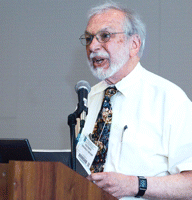Comorbid Conditions Complicate Veterans' PTSD Treatment
Abstract
Treating combat-exposed troops for posttraumatic stress disorder (PTSD) might be simpler if that were the only condition that required care, but they usually have other, related medical problems, said an Army psychiatrist at APA's annual meeting in Honolulu in May.
"There is a real physical basis for the experience of PTSD in these troops." said Maj. Gary Wynn, assistant chief of inpatient psychiatry at Walter Reed Army Medical Center and a researcher at the Center for Military Psychiatry and Neuroscience in the Walter Reed Army Institute of Research (WRAIR). "The somatic complaints line up with actually having medical disorders."
The leading predictor of PTSD is combat exposure, said Wynn. "The more combat, the more PTSD."
A study by fellow WRAIR researcher Charles Hoge, M.D., in 2004 found that soldiers with PTSD have about twice the rate of screening positive on the PHQ-15, of back and lumbar problems, and of more than two sick calls a month compared with colleagues not suffering from PTSD.
They also display double the usual rates of the psychological, social, and interactive aspects of PTSD—anger, mistrust, panic, guilt, or dissociation, said Wynn, who was reporting findings derived from a collaborative effort with Hoge.
However, those symptoms are too often discovered by screening and survey work, not when a soldier comes forth with complaints in a clinic visit, he said.
The Department of Defense's response has been to screen troops repeatedly, train and educate them about mental health, and increase the opportunities for mental health treatment by hiring more mental health professionals.
"The problem is, the math doesn't add up," said Wynn.
Less than 50 percent of soldiers with symptoms show up for treatment, he said. Between 20 percent and 40 percent of those participating in randomized clinical trials of treatments drop out. In the end, perhaps 20 percent recover.

Matthew Friedman, M.D., Ph.D., says that more needs to be known about what it is about the pathophysiology of PTSD or depression that leads to increases in cardiovascular or other comorbidity. Friedman is executive director of the Department of Veterans Affairs' National Center for PTSD in White River Junction, Vt.
Many of the studies of medications proposed to treat PTSD that showed little or no efficacy were conducted in highly selective populations, largely Vietnam war veterans, said discussant Matthew Friedman, M.D., Ph.D., executive director of the Department of Veterans Affairs' National Center for PTSD in White River Junction, Vt.
"The problem here is chronicity," said Friedman. "Those trials were conducted with a hard core of treatment-refractory patients 30 years after the war, not in young people recently back from Iraq and Afghanistan."
To boost treatment and recovery rates, the military services have to look at the barriers to care in a broader way to seek methods for improving access and willingness to seek care, said Wynn.
For instance, one recent study found that negative perceptions of mental health care are as important as the stigma surrounding mental illness itself. That study found that 25 percent of troops don't trust mental health professionals, 15 percent plan to work out their problems on their own, and 18 percent would see a mental health professional only if it were the last resort, said Wynn.
New approaches for increasing treatment participation rates include collaborating with primary care providers, especially by using physical symptoms as useful biomarkers for psychological problems. Other possibilities include "disguising" mental health care professionals as primary care people and greater use of complementary and alternative medicine, which must be doing a better job of engaging patients because patients usually have to spend their own money for such care, he said.
In addition, "we need to know more about what it is about the pathophysiology of PTSD or depression that leads to increases in cardiovascular or other comorbidity," said Friedman. "But that is also why it is appropriate to move treatment for PTSD and depression into primary care."
"We must keep patients involved and keep them coming back" for treatment to have any effect, said Wynn.
Randomized, controlled trials indicate that all exposure-based treatments have benefits in PTSD, he said. "Tailoring them to individuals is more important than the choice of treatment," he said. "We need to extend our reach to increase treatment retention."



